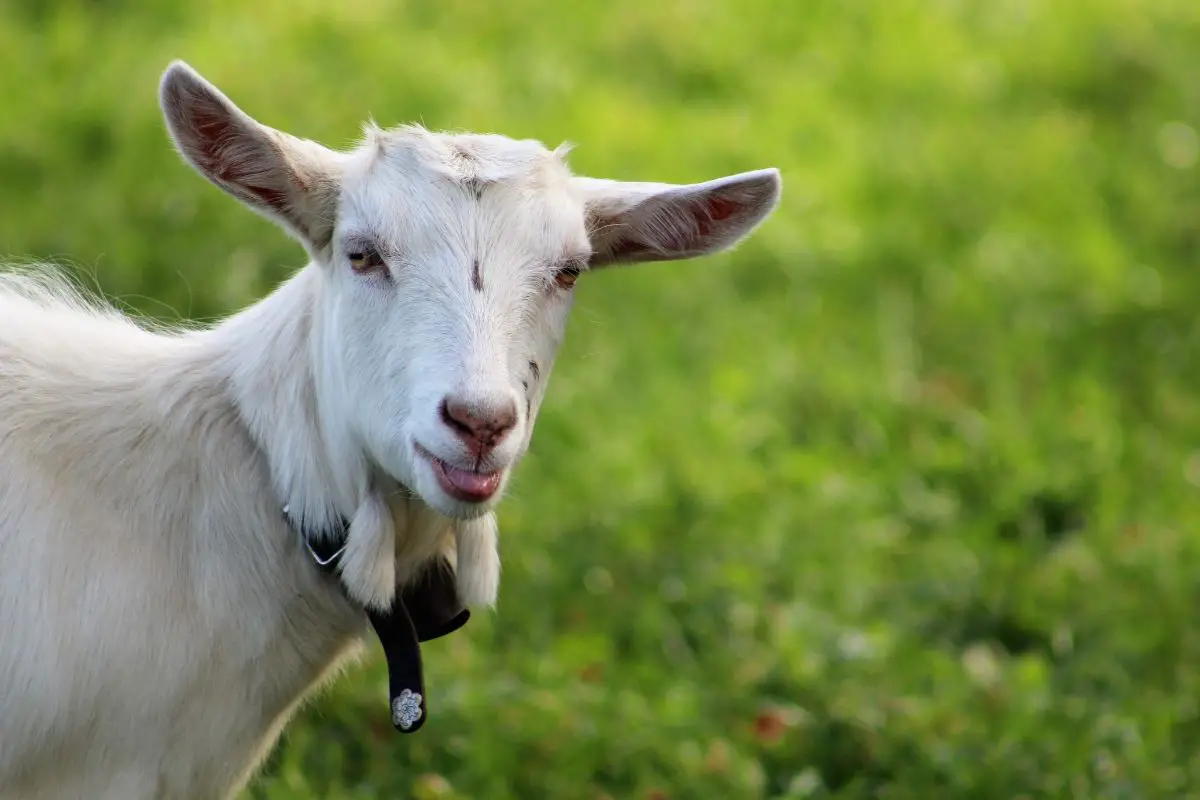
The goat is a herbivorous mammal belonging to the Bovidae family and the Caprinae subfamily. Domesticated goats can live almost anywhere with people, whereas wild goats mostly live in highly elevated areas like rocky mountains. These hair-coated animals are browsers, which means they’ll feed on roughage (hay, grass, twigs, tree branches, grains) after they test those with their upper lips.
An adult goat can be anywhere from 44 to 308.6lbs, with an average length of 1m, and has an average lifespan of 15 to 18 years. People generally keep goats in meadows, farmland, woodland, and other similar places where goats can have plenty of shrubberies to eat. They are aggressive and tend to establish dominance in a social group.
Most goats have horns that grow up and then curve downwards. There are many animals similar to goats owing to characteristics, identity such as belonging to a particular family or subfamily, and many other reasons. In this article, we’ll introduce you to the top ten animals similar to a goat.
1. Sheep
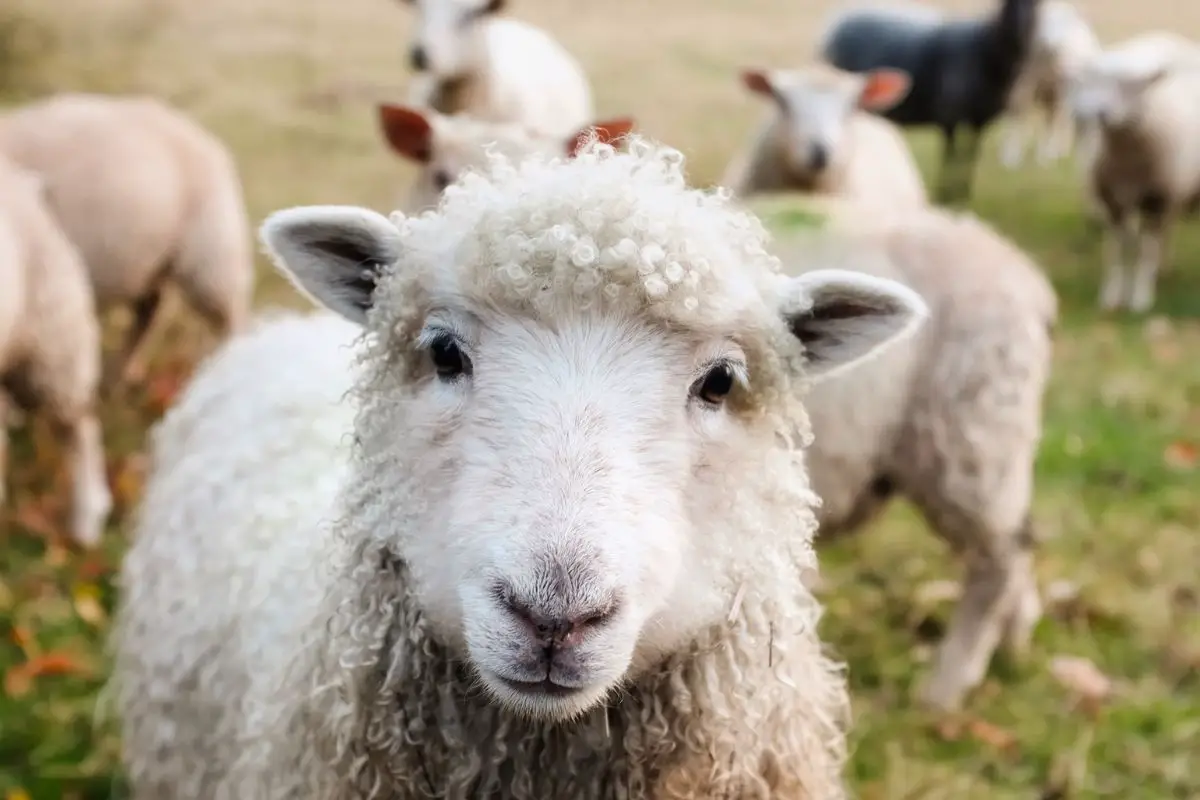
The most closely related animal to a goat is the sheep. But why so?
Description
Sheep are herbivorous mammals. Typically, they live an average of 10 to 12 years, weigh 100 to 350lb, and have an average length of 1.2 to 1.8m. Most breeds of sheep prefer grazing on grass and other roughage without the woody stalks.
They are naturally adaptive and live primarily on steep areas, bogs, moorland fringes, and rough grasslands. All sheep need water, shelter, and a large grassy pasture to graze on. They have an excellent social instinct and a flock mentality, which means they bond well with other sheep in their flock and often other animals too.
Their only defense mechanism during danger is fleeing.
How It’s Similar to a Goat?
Sheep and goats are from the same subfamily, Caprinae. Both are hooved animals or ungulates. Sheep and goats are also ruminants, which means they have four-chambered stomachs.
Both are domesticated animals and have similar gestation periods.
How It’s Different From a Goat?
Sheep have a wool coating, and their tails are always pointing down, compared to goats whose tails point up. Sheep usually don’t have horns, but for those that do, their horns curl down on the sides of their head. Their upper lips have a distinct groove in the middle, which helps them graze and distinguish between grass and other roughage efficiently.
Unlike goats, sheep are aloof and distant and always stay in the flock.
2. Deer
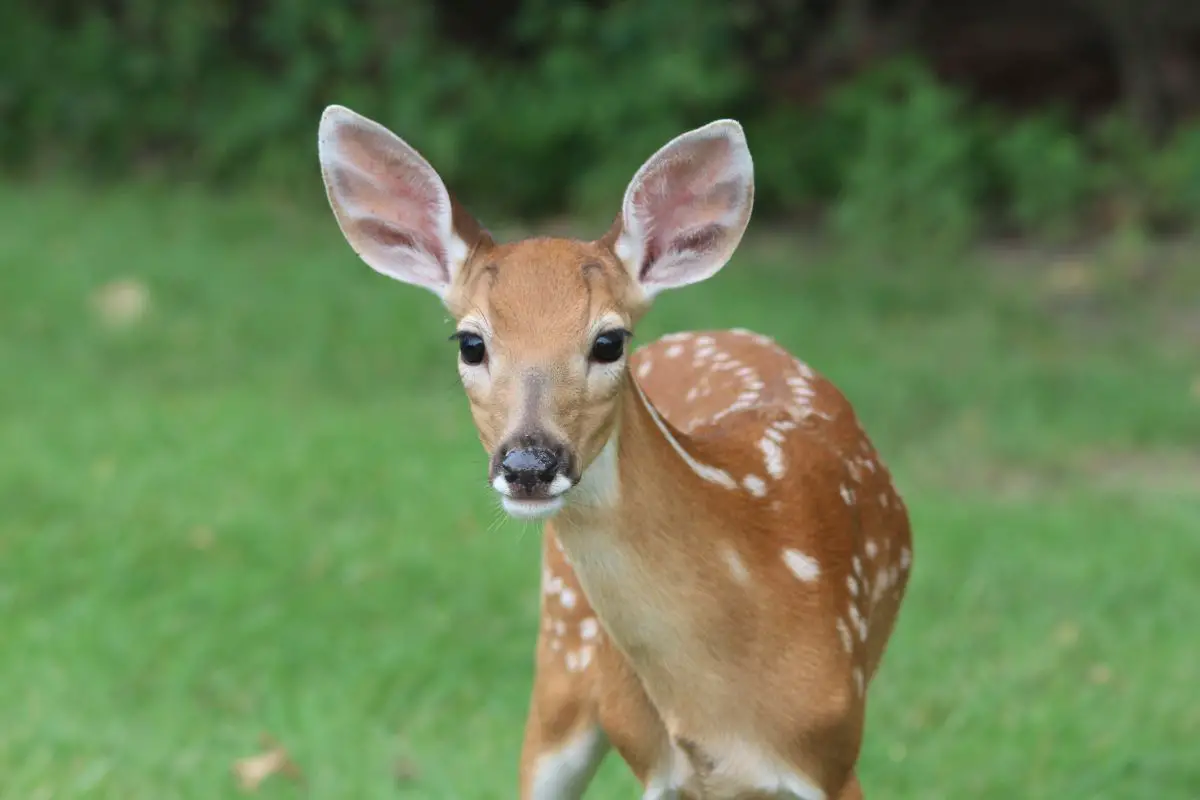
Deer is another animal similar to a goat. Let’s see why.
Description
Deer, another herbivorous mammal related to goats, live for an average of 6 to 14 years in captivity. An adult deer weighs 80 to 160lb on average, and the height is between 1.5 and 2.1m. Deer live in grasslands, rain forests, deciduous forests, scrublands, wetlands, and even mountains.
They feed on acorns, crops, grass, nuts, and vegetation. Deer are shy animals, so you’ll always see fewer than there actually are. However, they’re always alert to danger and act quickly, mostly by running away and seeking cover.
How It’s Similar to a Goat?
Both are members of Artiodactyla, which means they’re even-toed ungulates. Both are browsers and ruminants, so they chew on their cud.
How It’s Different From a Goat?
They aren’t part of the same taxonomic family, although they fall under the same taxonomic order. For example, deer belong to the Cervidae family and carry antlers, unlike goats. Deer are also very shy and non-confrontational.
However, they’ll fight to establish dominance within their herd.
3. Antelope
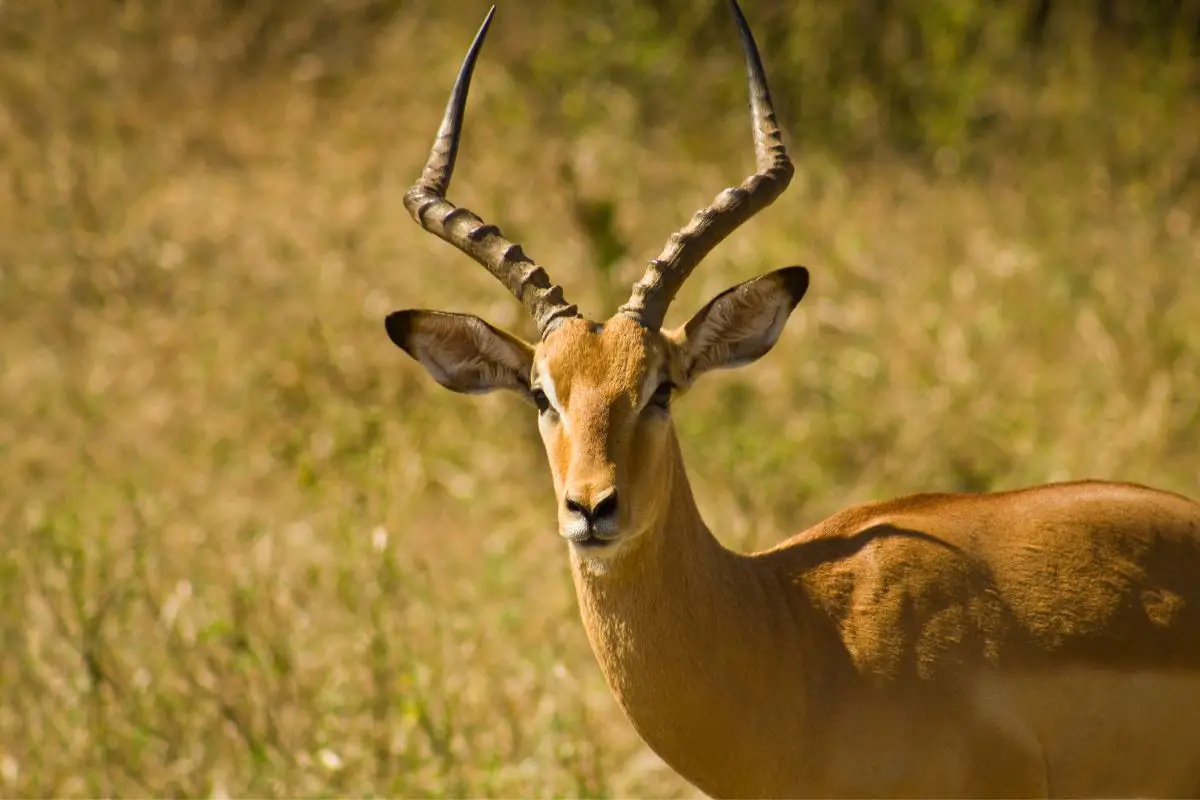
Another animal similar to the goat is the antelope. Let’s look at the reasons.
Description
Antelope, a herbivorous mammal of diverse species, lives an average lifespan of 10 to 25 years in captivity. It weighs 1,100 to 2,000lbs depending on gender and age and has an average length of 1.4m. Antelopes live in forests, rocky terrains, woodlands, and savannah grasslands and feed primarily on grass, shoots, and seeds.
You’ll find most of the species spread throughout Africa. Typically territorial by nature, antelopes communicate through whistles, moos, trumpets, and loud barks. They mark their territories with their scent and use marks on their legs, ears, head, or rumps to mingle with their fellow mates.
Male antelopes use their horns to defend against predators and compete with other antelopes during mating season. Their escape mode depends on the species, from running to jumping over shrubs to stotting.
How It’s Similar to a Goat?
Both antelope and goat belong to the Bovidae family. Both are even-toed ungulates and are ruminants. Antelopes also have fur coating and horns.
How It’s Different From a Goat?
It’s difficult to domesticate antelopes. Unlike goats, their horns vary in shape and size depending on their species. Their tail length and position vary across species.
Antelopes use the marks on their body to mingle with other antelopes. Females of most species have horns, usually larger than their male counterparts. Their gestation period varies across species.
For instance, some have gestation periods that are closer to that of goats, while others tend to have them for much longer.
4. Wildebeest
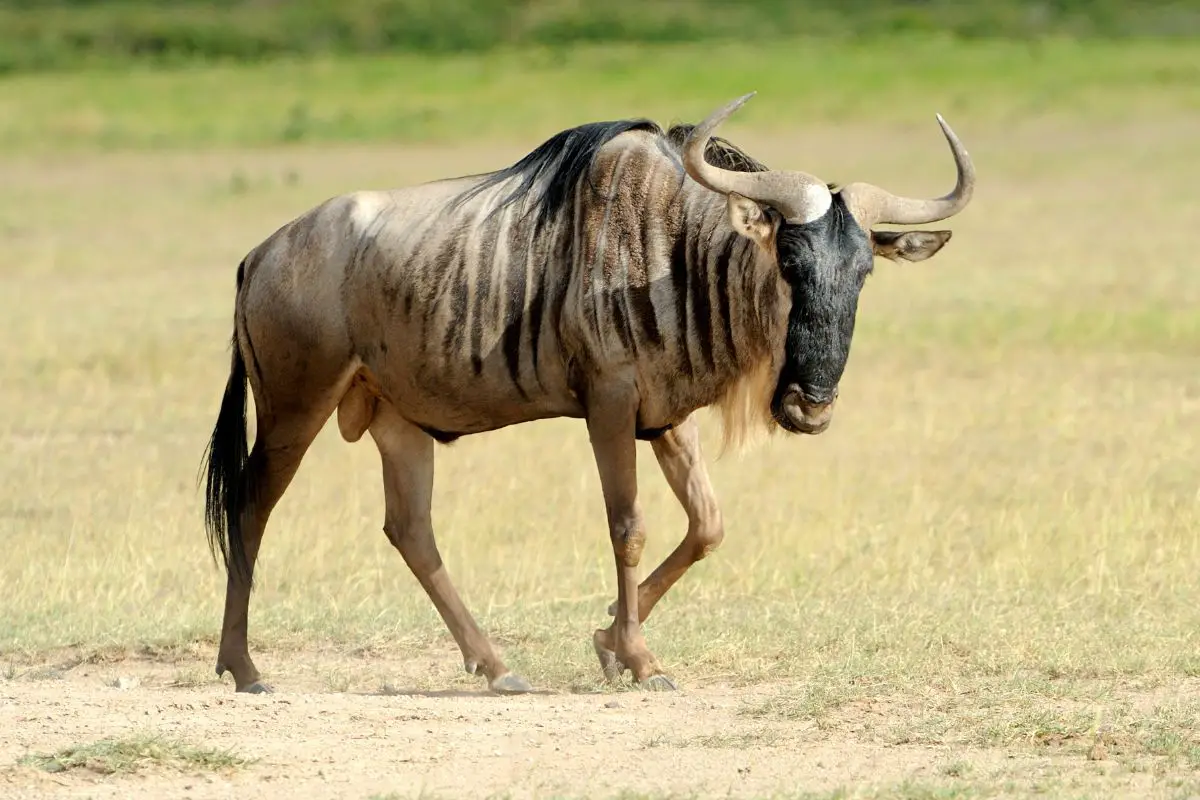
One of the species of antelopes is wildebeest. Let’s get to know them.
Description
Wildebeest, another herbivorous mammal in the Bovidae family, live for an average of 20 years and typically have a length of 1.7 to 2.4m. Depending on gender, an adult wildebeest weighs from 310 to 639lbs. They are primarily located in Central, Eastern, and Southern Africa and feed on short grasses on savannah grasslands and woody plains.
Wildebeest are social, territorial animals. They travel in large herds and constantly graze day and night. Wildebeest may look violent but are pretty submissive, playful, and intelligent creatures.
They’re violent only during mating season. They communicate through sight, smell, and bellowing. Their primary defense technique is running in herds while protecting the younger ones in the middle.
Although submissive, wildebeest tend to be very strong and can often injure even a lion.
How It’s Similar to a Goat?
Wildebeest is closely related to goats as both belong to the Bovidae family. Both of them are furry, horned, even-toed ungulates and are ruminants.
How It’s Different From a Goat?
Wildebeest belongs to the Alcelaphinae subfamily. They have long legs and long faces, and both males and females have horns. Their gestation period is much longer than that of goats.
Their horns curve upwards and are broad and heavy as those of a buffalo. When it comes to being defensive, wildebeests can be aggressive, unlike goats, especially with their horns. Through such means, they can brutally injure their predator as and when required.
5. Impala
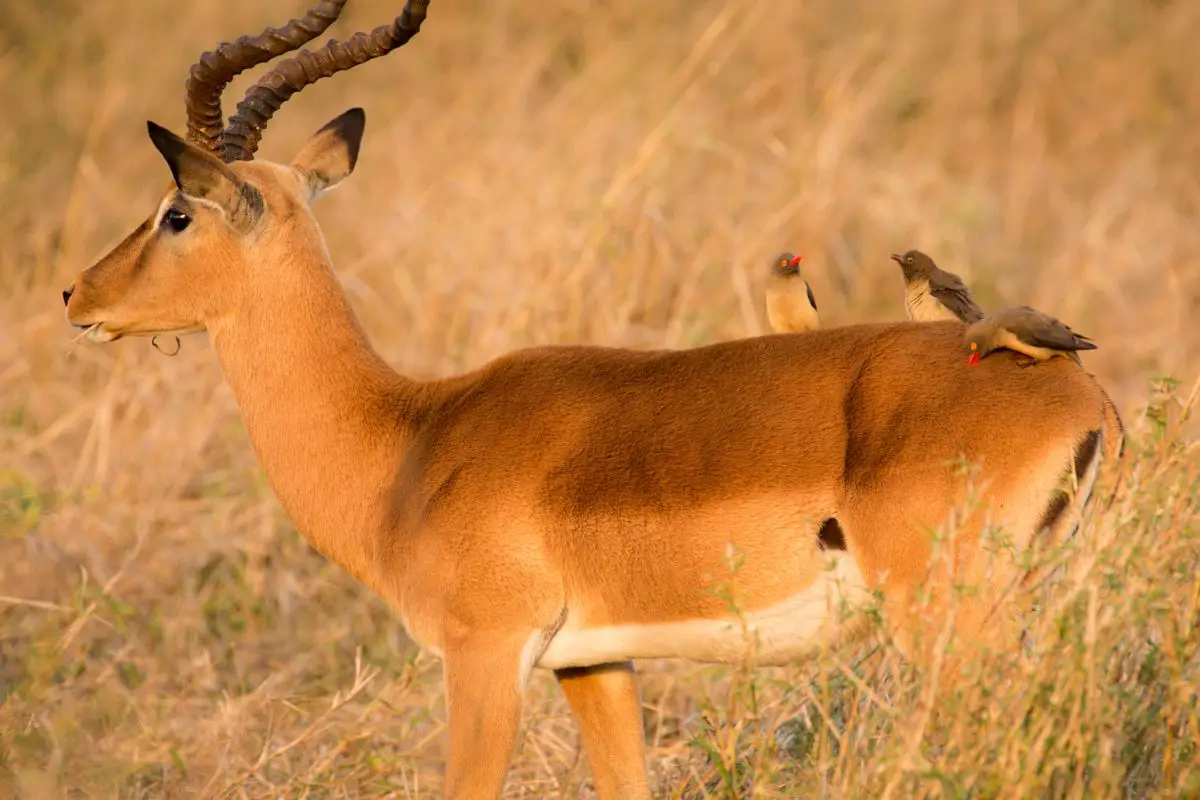
Impala is another species of antelope. But how is it similar to a goat?
Description
Impala, another herbivorous mammal under the Bovidae family, lives an average life of 17 years in captivity. Depending on the gender, an adult impala can weigh between 88 and 168lbs and are 1.4m long. You can find impalas in savannah grasslands and light woodlands in Eastern and Southern Africa.
They prefer living near water sources, but if there’s a drought, they live near places with succulents. Impalas are both browsers and grazers, depending on the availability of food. They feed on soft and nutritious grasses, forbs, monocots, dicots, fruits, and acacia pods when available.
You can observe three distinct social groups among impalas – bachelor herds, female herds, and territorial males. Their social behavior can vary between territorial and gregarious depending on the geography and climate of their habitat. Usually, the males become vocal during ‘rutting’ or mating season.
Impalas stay away from lands with tall grass as predators can hide there. For the most part, they remain vigilant and stay in large groups. Impalas bark when they’re in danger to alert others in the herd.
How It’s Similar to a Goat?
As mentioned earlier, impalas belong to the Bovidae family. They also browse like goats and are furry, horned mammals. Just like goats and most other members of the Bovidae family, impalas are ruminants.
Both are high jumpers.
How It’s Different From a Goat?
You can’t domesticate impalas. Impalas are active during the day but feed and rest at night. Although impalas eat a lot of things, they prefer things that are soft to eat.
Female impalas, also called ewes, have no horns, unlike female goats, who have short horns. They also have a longer gestation period than goats.
6. Gazelles
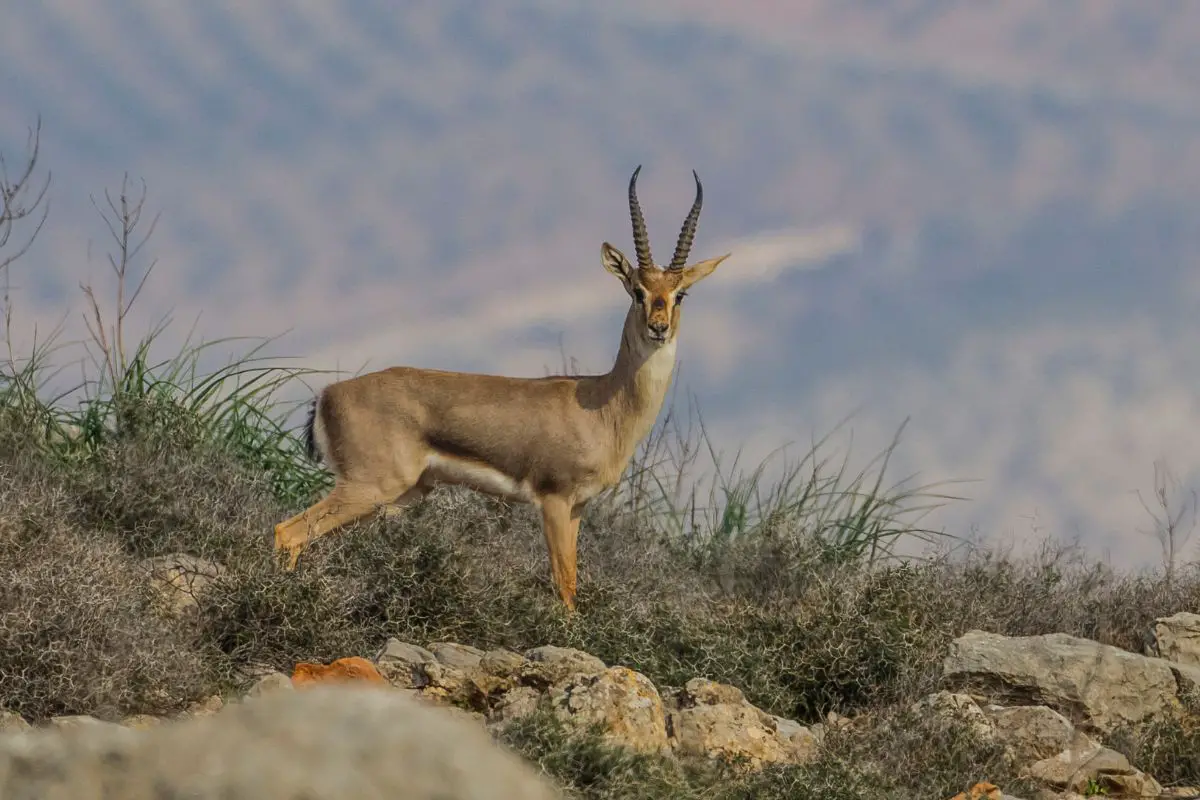
Another species of antelope that is similar to a goat is the gazelle. They are also very closely related to an impala.
Description
Gazelles are another herbivorous mammal that live for 12 to 15 years in captivity. They weigh between 26 and 165lbs, depending on gender and location, can be between 1.1 and 1.3m long, and are swift animals. You can find gazelles in Africa and Asia.
They have adapted to inhibit arid lands such as dry savannas, waterless steppe, and deserts. When a predator approaches, a gazelle starts stotting to escape from the predator and also warns others in the herd. This helps them gain an edge over the predator.
How It’s Similar to a Goat?
Gazelle falls in the Bovidae family and has a nice shiny fur coat. They are also browsers and ruminants and are even-toed ungulates. Although their gestation period varies, it’s pretty close to that of goats.
They are just as social as goats and live well in herds.
How It’s Different From a Goat?
Gazelles have ringed horns that curve backward and up. When in danger, they pronk to warn their herds about predators. Unlike goats, they can survive without drinking water as they absorb moisture from their food.
7. Ibex
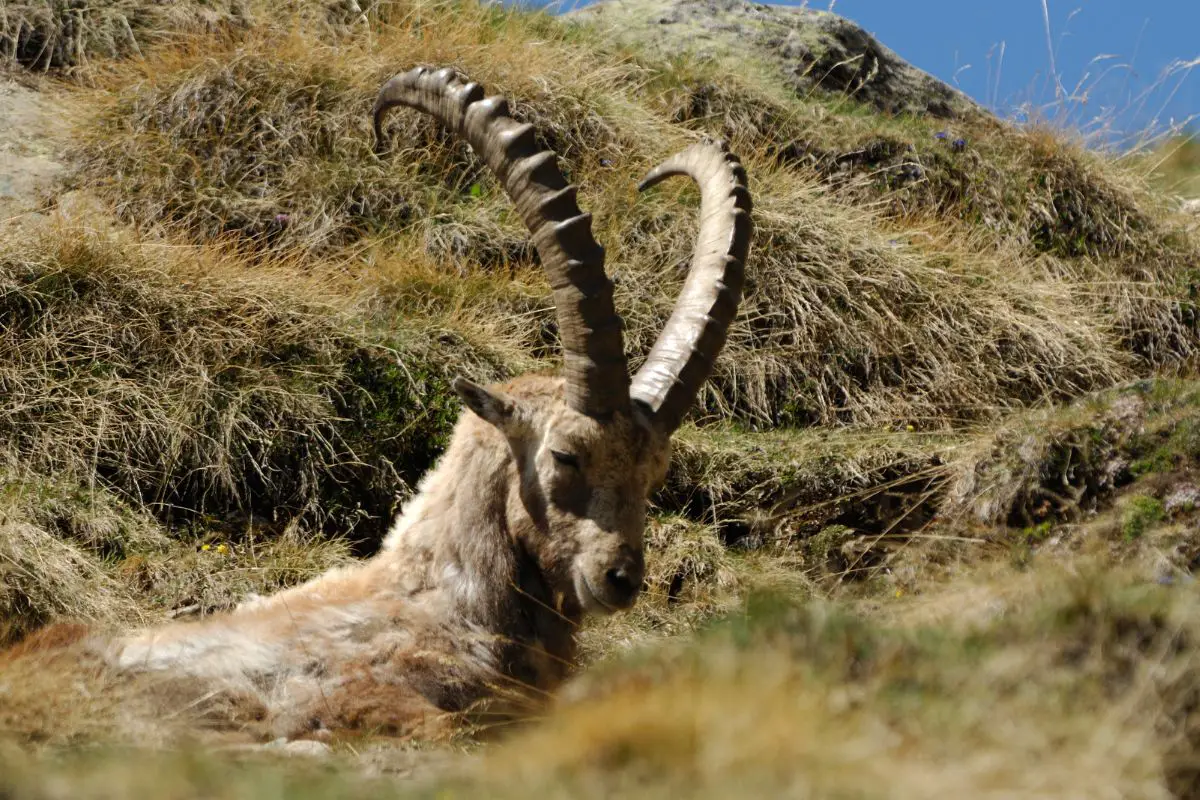
Ibex is relative to a wild goat that typically lives in rocky and mountainous areas. Let’s see how similar it is to a domesticated goat.
Description
Another member of the Bovidae family, ibex, can weigh anywhere from 127.9 to 286.6lbs and can be 1.2 to 1.7m long, depending on their species. The typical lifespan of an ibex in the wild is 17 years. They are primarily grazers and feed on grasses, shrubs, and bushes.
Ibex typically live in mountainous areas and tall cliffs, although you can find some in alpine forests and woodlands. They are social animals and live in herds. Furthermore, ibex typically have two kinds of herds- a bachelor herd and a herd where females stay with their offspring.
They’ll only come together during the mating season. Ibex can jump up to 1.8m from a standstill. Usually, when an ibex faces danger, it’ll flee from its predator. But when it’s the mating season, it’ll charge with its horns.
How It’s Similar to a Goat?
Ibex are basically wild goats that you will find at great heights. They’re just as heavy as domesticated goats. Ibex are also ruminants and even-toed ungulates.
How It’s Different From a Goat?
Both male and female ibex have horns that are thick. Moreover, they have ridges, they tend to be long, and they also curve slightly backward into a semicircle. Both will attack their predators.
However, unlike goats, ibex are grazers and live on high terrains.
8. Japanese Serow
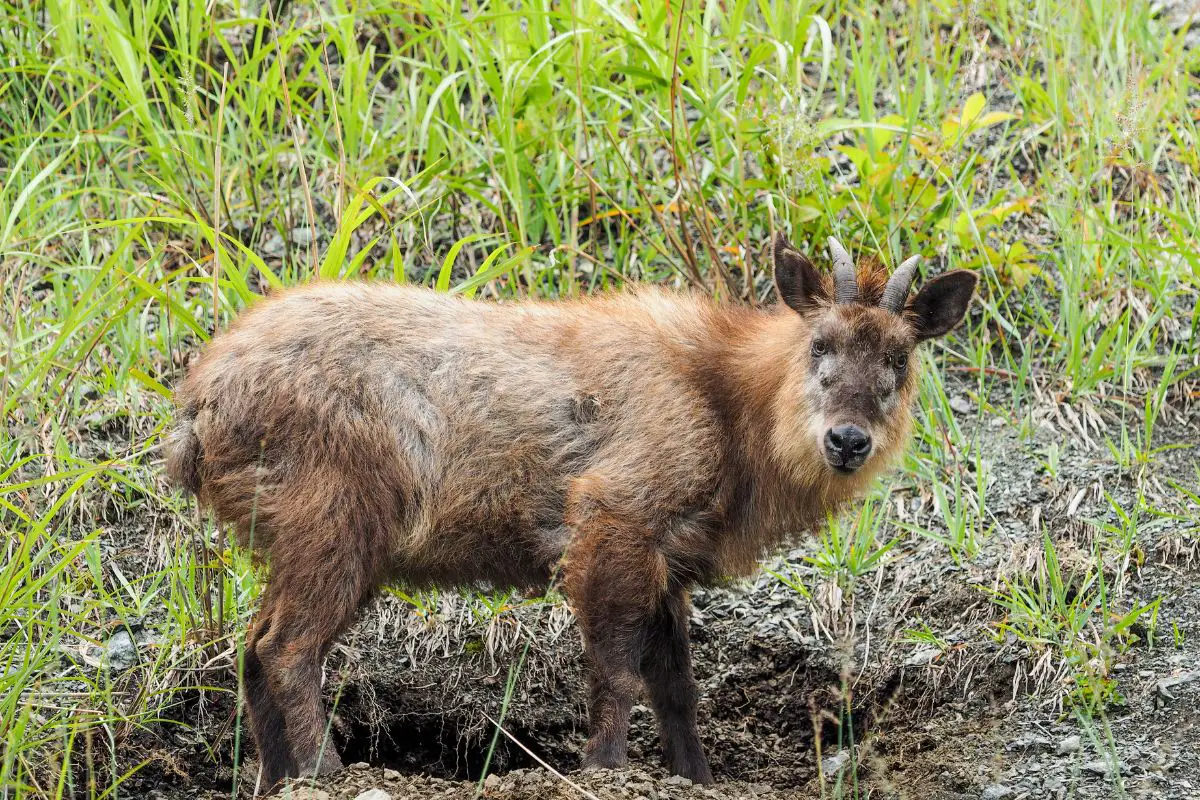
A Japanese Serow is a Japanese goat-antelope. But how similar is it to a goat?
Description
A Japanese serow, another herbivorous mammal in the Bovidae family, lives from 20 to 25 years and weighs an average of 66 to 110.2lbs. Their body length is approximately 1.3m. Japanese serows mainly live in forested mountainous areas, alpine meadows, and grasslands.
They are sedentary and territorial, and you’ll find them either solitary or in small groups mostly comprised of family members. They mark their territories through a gland secretion that has a distinctive smell. When they see predators approaching, they freeze in their position under a low visibility area or lay low.
How It’s Similar to a Goat?
Japanese serows are even-toed ungulates and are ruminants just like goats. The Japanese serows that feed in the daytime are browsers just like goats. In terms of diet, they feed on acorns, plane roots, and fleshy or coniferous leaves.
How It’s Different From a Goat?
Its fur and tail are very fluffy. Moreover, Japanese serow tends to have a more extended gestation period than goats. One more difference lies in the type of horn each animal has.
As far as Japanese serow are concerned, both genders have horns but are shorter and not as curved as the horns of goats.
9. Tahr
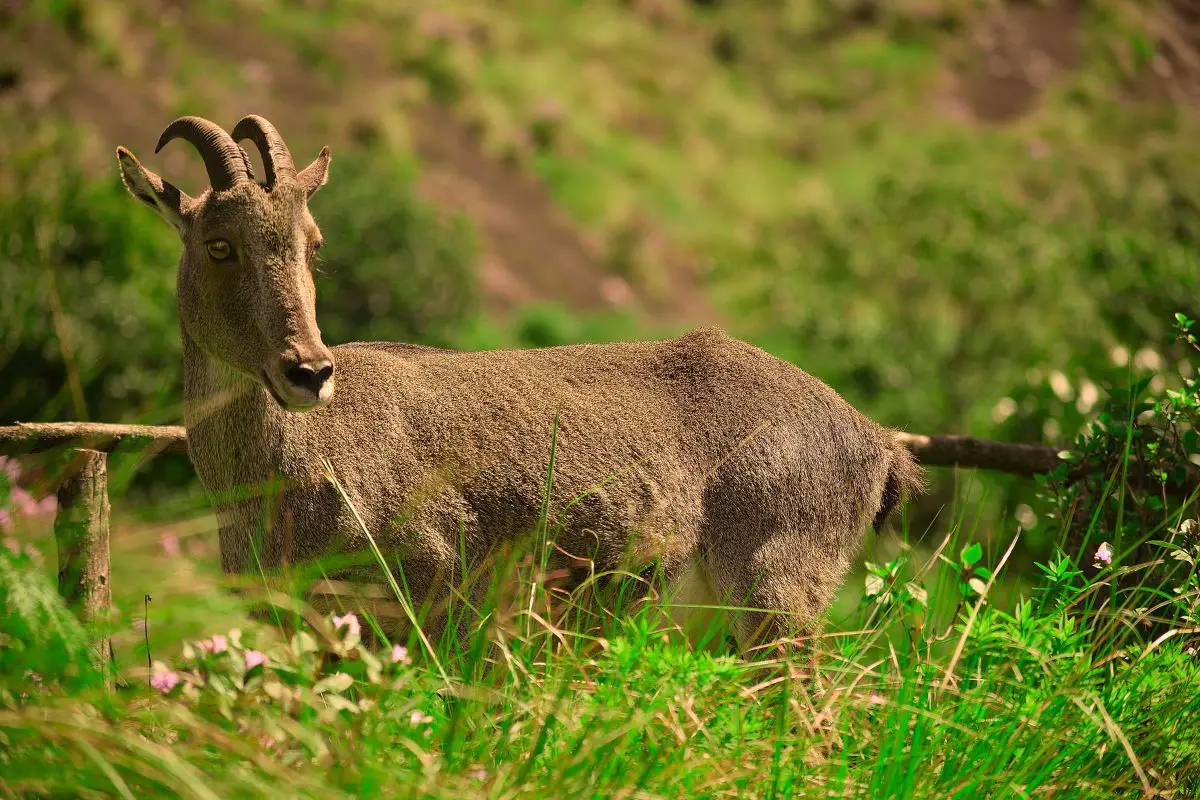
Tahr is another wild goat found in Asia. Let’s know more about them.
Description
Tahr, another member of the Bovidae family and a herbivorous mammal, is native to Asia. It lives for 14 to 22 years, weighs an average of 77.2lbs, and has an average body length of 0.9 to 1.4m. Three species of Tahr are available – Arabic, Himalayan, and Nilgai.
They graze on grass and browse on leaves and fruits. They feed early in the morning, rest the entire day at one spot, and feed again in the evening. You can find them in one position day and night.
You’ll find them in grassy plateaus and woodlands. They live in all-female small herds or in mixed packs. They communicate through sight, smell, and sound.
When faced with danger, they defend their herd with their horns.
How It’s Similar to a Goat?
Just like goats, Tahrs are even-toed ungulates as well. They have horns and fur coating like goats. Moreover, just like female goats, female tahrs have smaller horns than males.
Although more diverse, the gestation period for tahr is quite similar to the goat.
How It’s Different From a Goat?
Tahr horns are thick but relatively shorter, and their furs are long and thick. They browse and graze, whereas goats are mainly browsers. Their tails are small and furry.
10. Chamois
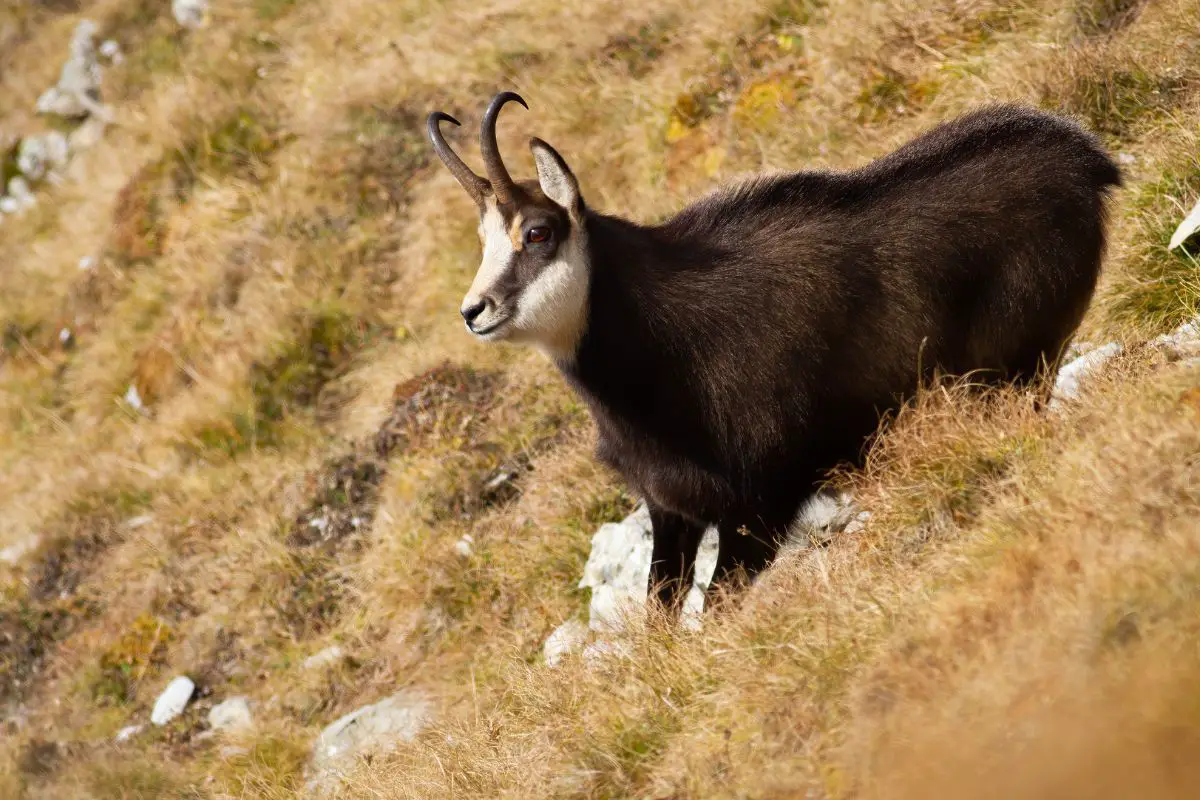
The chamois is a goat-antelope native to the European mountains. Let’s see how it is similar to a goat.
Description
Chamois are small herbivorous mammals under the Bovidae family, weighing between 55 to 132lbs. In captivity, chamois can live for 22 years and reach a length of 1.1 to 1.4m. Chamois live in moderately high terrains that are rocky, precipitous, and rugged.
During summer, they move to alpine meadows, feed on highland grasses and herbs, and eat conifers, barks, and needles from trees during winter. The females and their offspring live in a moderately sized herd, and the males live by themselves. However, during mating season, these herds become one.
During this time, the male chamois participate in a fierce battle to establish their dominance. Predatory attempts are rare on chamois as they’re always alert and unapproachable. They can always run fast and jump as high as 2m when a predator approaches them.
The females in the herds can also defend their offspring if they’re under attack.
How It’s Similar to a Goat?
Chamois are even-toed ungulates with a gestation period similar to goats. Like goats, chamois are ruminants.
How It’s Different From a Goat?
A chamois’ tail isn’t generally visible unless it’s mating. Although furry, their fur is thicker than that of goats. Their horns are straight-ish and short and are hooked right above their eyes. Unlike goats, chamois are both browsers and grazers.
Their heads are fragile, so instead of battling with their horns and head, they chase each other across steep areas and try to hurt other sensitive areas.
FAQs About Animals Similar to Goats
How Were Goats Domesticated?
Goats are believed to have been domesticated around 10,000 years ago in Iran. Archeological evidence suggests that goats underwent massive genetic changes through centuries of domestication and captivity.
Are Goats Picky Eaters?
Although they’re known as browsers and will seemingly eat anything, they actually select what they want to eat with their upper lips and feed only on nutritious options available. They usually eat hay, grass, weed, grains, and tree bark.
Which do Animals fall Under the Bovidae Family?
The Bovidae family consists of animals that are even-toed ungulates and ruminant mammals. Besides goats and the other animals mentioned in the article, some other animals under the Bovidae family are cattle, bison, and buffaloes.



